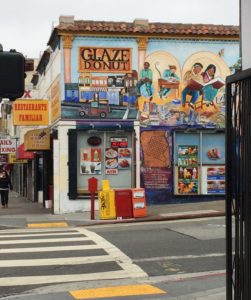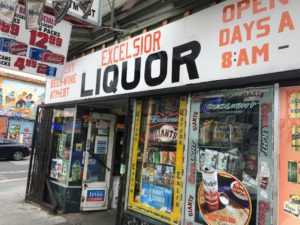
“I grew up between 19th and San Carlos, which is little alley right on the Mission, between the Sureños and the MS. It just happened that one gang was on one corner of my street and the other gang was on the other side of the street.”
This is the starting place of Arianna Vargas’ story, a YLI youth leader who has become a shining role model and champion for young people like herself.
Vargas, now 21 years old, has spent most of her life in San Francisco’s Mission District, an iconic Latino neighborhood that has shifted dramatically over the years. “I remember always seeing police officers trying to stop people, whether they thought that they were in gangs or just looked like they were in a gang.” As gentrification has literally changed the faces of the people teeming the street corners on Friday nights, the level of policing has decreased. She remembers feeling confused: these new people were partying and drinking, but they were not being targeted by the police.
School was no refuge. Vargas was constantly kicked out of class, even as she encouraged her friends to complete their assignments. She had a deep feeling that school was simply “not for us.”
Vargas found solace – a second family – in the neighborhood’s Latino-centered after school programs. “Me and my mom, I feel like we grew up with each other, because she was a teen mom.” A product of the foster care system, Vargas’ mom became involved in Loco Bloco, Dance Mission, and Mission Girls. Led and delivered by people of color, conversations revolved around equity and education. “It was a different perspective on education and I never thought that could be translated within the institution.” These programs, which required that participants stay in school and maintain their GPAs, kept her grounded and moving forward.
Yet, even with these outside supports, Vargas hadn’t planned on going to college: “It wasn’t talked about when I was in high school. I definitely did not picture myself there, I wasn’t even thinking about it at all…I didn’t have enough people talking to me about their college experience, or the empowerment that you get out of it, so I really didn’t understand the point of it at the time.”
Then, in the fall of her senior year, Vargas got pregnant. She had wanted to keep the child, but her mother convinced her to terminate the pregnancy. Funds were tight, they shared their space with roommates, and Vargas would have had to move out and support herself and her child on her own. “I just felt very lost and alone…I had to process everything by myself, and I was working four different jobs.”
That is when things began to shift. In her final year of high school, Vargas began going to night school to make up for classes she had failed. She took an AP course to raise her GPA. She lost a lot of friends in the process who couldn’t understand and didn’t support her new interest in school. “It was the hardest time in my life, but it was also the best time. Working at the Exploratorium, I made a lot of friends who were thinking about college and had been thinking about it for a while. They are still my friends to this day. Even though they didn’t know what was going on at the time, I really appreciated all the love and support they gave me.”
Blossoming into Leadership
Vargas was admitted to SF State University, and was introduced to the Youth Leadership Institute (YLI) through the Metro College Success Program. She began working on YLI’s Community Action Model campaign at the end of her freshman year. The campaign seeks to reduce storefront advertisements that promote unhealthy behaviors such as consuming alcohol, tobacco, sugar-sweetened beverages, and junk foods.

Studies show that tobacco companies focus advertising in targeted communities, specifically low-income and communities of color, so it is no surprise that these kinds of ads are rampant in the Mission, Bayview, Excelsior, Sunset and Tenderloin districts. Vargas was shocked when she and a group of YLI youth toured their neighborhoods, collecting photographs for a YLI photovoice project. Through the camera’s lens, the youth began to see the disparities among the city’s diverse communities. The ads were everywhere in her neighborhood: “I had never noticed!” said Vargas. “We walk by this all the time, we see this every day…we never realized how much this was in our face. From there, we started the conversation, what does this mean? What impact does this make, seeing this every day?”
This over-saturation and exposure to unhealthy advertising leads to unhealthy outcomes: residents of neighborhoods with high concentrations of tobacco retailers are statistically at greater risk of tobacco related disease and death. According to a new report, youth are 3 times more likely than adults to be influenced by tobacco advertisements. In these neighborhoods, convenience stores are core to community life: “When we asked our peers in San Francisco, almost every one visits a convenience store every single day. Much of the unhealthy advertising is youth-oriented, using bright colors and cartoon images,” said Vargas.
The youth began to conduct community research, surveying neighborhood residents, and building relationships with local merchants. Small convenience stores are an important part of community life, and store owners must be part of the solution to creating healthier communities. After meeting with the youth, many of these merchants began to support the idea of limiting unhealthy advertising, and some are already putting up community murals on their storefronts.
“I used to have hundreds of signs up. All of our windows were covered with neon signs. Now, I have one, and I try to turn it off as much as possible. People know what they can find here—I don’t need to advertise it. Why have those signs negatively influencing the neighborhood?” said Sam of Golden Eagle Market. Alex, owner of Decamere Market said: “I don’t keep my neon signs on anymore. All of our storefront murals were done by local artists here in the community. This is our community. The murals are better for my store and for the neighborhood.”
Vargas and other YLI youth leaders are now working on legislation to reduce the amount of ad space on storefront from 33% to 15%. The idea is to tackle the normalization of destructive behaviors, which undermines efforts and funds spent on individual prevention. Ads could then be replaced by cultural artwork, which, one study shows, fosters positive norms while building community identity, appreciation, and pride.
The youth have met with City Supervisor Hillary Ronen and former Supervisor Eric Mar. They have also presented and received an endorsement from the SFUSD School Health Program, and are working to engage the City’s Planning Commission and Youth Commission to gain their support. The Community Action Model campaign is deeply significant to Vargas, who remembers drinking and smoking at 12 years old: “I feel like it was subconscious that all of us who live in communities of color were being targeted to smoke and drink. That was just the thing to do.”
Looking forward
Vargas is now beginning her last year at SF State University, and will graduate in Spring with 2 degrees. She is applying to graduate school, and dreams of becoming a high school teacher and college professor. In the meantime, she will continue to work on the Community Action Model campaign. “It’s exciting knowing that future generations are going to be impacted by this. Hopefully it will affect them where they don’t get exposed to these things,” she said of the campaign.
